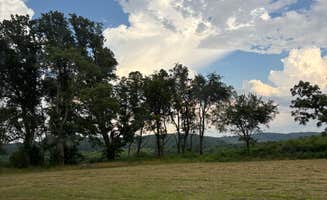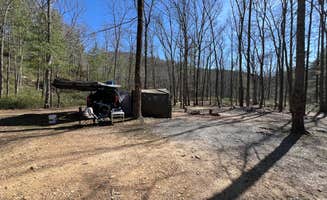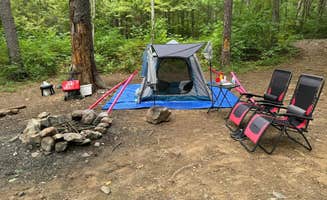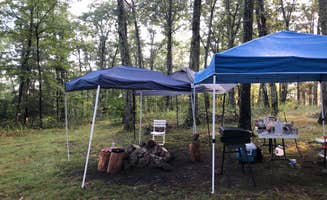Primitive camping near Appomattox, Virginia offers opportunities in the surrounding national forests and wildlife management areas. Located in central Virginia, the region sits at elevations ranging from 700-1,200 feet with deciduous forest dominating the landscape. Summer temperatures typically reach 85-90°F with high humidity, while spring and fall offer milder conditions in the 60-70°F range. Winter camping remains possible with daytime temperatures often above freezing, though occasional snow and ice storms can affect road access.
What to do
Hiking to panoramic views: Spy Rock provides ambitious campers with exceptional 360-degree views of the Shenandoah Valley after a steep 1.5-mile hike. "The hike up is brutal but the top is absolutely worth it," reports one camper at Spy Rock. The summit area features a small clearing for camping and requires a rock scramble to reach the viewpoint.
Stream exploration: Many dispersed sites along forest roads feature creek access perfect for filtering water or cooling off. At Dispersed Camping Site off FR 812, campers appreciate the "hiking trails and easy access to the stream" with "several flat areas for tents" positioned near the water.
Mountain drives: Scenic forest roads connect many camping areas, offering their own recreational value. The drive to Reservoir Road campsites requires patience, as one camper noted: "This was about 5 miles of dirt road to get to it." Despite the long approach, these sites provide solitude along the Pedlar River with "multiple spots along reservoir rd."
What campers like
Established amenities: Despite being primitive, many sites feature useful improvements. At George Washington National Forest off 812, campers found "a fire ring and man made stone oven at the site we chose" along with level ground for tents. Another camper mentioned their site was "clean, creek for water if you have filter. Nice fire ring and wood."
Solitude options: The remote nature of these sites provides quieter camping experiences compared to developed campgrounds. One camper at James River Wildlife Management Area reported: "I was unsure if I was in the right area. I never saw another person camping," while another camper valued that the area is "quiet, secluded, and convenient."
Trail connectivity: Many camping locations serve as gateways to trail systems. A camper at George Washington National Forest off 812 noted there's "a hike at the end of the road that takes you to a gorgeous summit & links to AT!" Another observed "access to the App Trail on the road so you might see some hikers but it was real quiet otherwise."
What you should know
Seasonal considerations: Bug activity increases significantly during summer months. One camper at Reservoir Road Dispersed Campsite reported: "Went in August and it was very buggy, also had someone park pretty close." Fall and spring typically offer more comfortable conditions.
Arrival timing: Popular sites fill quickly, especially on weekends. "Definitely get there early to get a prime spot," advises one camper at George Washington National Forest off 812. Another noted "80% were full on a beautiful fall Friday evening around 6pm but still snagged one."
Road conditions: Most dispersed camping areas require driving on unpaved roads of varying quality. One camper at Dispersed Camping Site off FR 812 described "a very rocky path, about 50 feet long, to get into the campground, but then it is smooth and well laid out." Several sites lose cell service miles before arrival.
Tips for camping with families
Check fire regulations: Fire policies vary by location and season. Most sites in George Washington National Forest off 812 have established fire rings, with one camper finding "a giant fire circle in the middle and enough room to fit about 10 vehicles/groups if people don't mind being next to each other."
Pack all essentials: No facilities exist at these primitive sites. One visitor to Spy Rock explained: "It's literally just the top of a mountain, nothing but what you carry up with you." This includes water, as natural sources require filtration.
Consider accessibility: Some locations offer easier access for children than others. James River Wildlife Management Area - Dispersed Camping features "a gravel access road about .5 miles down the road that is well-maintained. It almost immediately opens up into an open field" making for simpler setup with children.
Tips from RVers
Size limitations: Most dispersed sites accommodate smaller rigs only. At James River Wildlife Management Area, an RVer noted the main area "opens up into an open field where large rigs of any size can fit. There is another site further down the road, but it is smaller and primarily used for truck campers and tents."
Clearance requirements: Forest roads often require vehicles with adequate ground clearance. One camper at George Washington National Forest off 812 mentioned "need some clearance in some spots" while another with a van reported "Multiple road sites that fit my van with room to spare."
Self-sufficient camping: No hookups or dump stations exist at primitive sites. Prepare to dry camp completely. A camper at James River Wildlife Management Area reported staying there regularly when working in Lynchburg, noting it is "20 minutes from the closest grocery store (Food Lion), liquor store, gas station, and propane supplier (Foster Fuels)."





